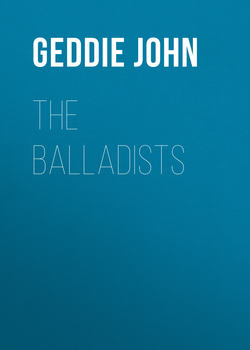Читать книгу The Balladists - Geddie John - Страница 4
CHAPTER III
BALLAD STRUCTURE AND BALLAD STYLE
Оглавление'Strike on, strike on, Glenkindie,
O' thy harping do not blinne,
For every stroke goes o'er thy harp,
It stounds my heart within.'
Glenkindie.
The old ballads were made to be sung; or, at least, to be chanted. An inquiry whether the traditional ballad airs preceded the words, or vice versâ, would probably lead us to no more certain conclusions than that of whether the egg came before the fowl or the fowl before the egg. Both ballads and ballad airs have come down to us greatly changed and corrupted; and probably it is the airs that have suffered most from neglect and from alteration. Notation of the simple and plaintive and sweet old melodies appropriated in the ears and lips of the people to the words of particular ballads came long after the transcribing of the words themselves. There are other elements of perplexity and difficulty in ballad music which require an expert to unravel and explain, and which cannot be entered into here. The subject is referred to only because, in the eyes of the original composers and singers at least, to dissever the words from the tune would have seemed like parting soul from body; and because no right notion can be gathered of the Scottish ballads without bearing in mind the part which the ancient airs have taken in framing their structure and in moulding their style.
Like the ballads themselves, the 'sets' of ballad airs vary with the localities; and even in the same district different airs will be found sung to the same words and different words to the same air. But of many of the older ballads, at least, it may be affirmed that, from time immemorial, they have been preserved in a certain musical setting which has not altered more in transmission from place to place and from generation to generation than have the ballads themselves, and which has so wrought itself into the texture and essence of the tale that it is impossible to think of them apart. The analogy of the Scottish psalmody may, perhaps, be used in illustration. In it, also, there is a 'common measure' that can be fitted at will to the common metre – in the psalms, as in the ballads, the alternation of lines of four and three accented syllables. In the one case, as in the other, there is a certain family resemblance, in the melody as in the theme, that to the untrained and unaccustomed ear may convey an impression of monotony. But to each ballad, as to each psalm, there belongs a peculiar strain or lilt, touched, as a rule, with a solemn or piercing pathos, often cast in the plaintive minor mode, that alone can bring out the full inner meaning of the words, and that is endeared and hallowed by centuries of association. As easily might we explain why the words and air of the 'Old Hundredth' or the 'Old 124th' belong to each other, as analyse the wedded harmony of the verse and music in The Broom o' the Cowdenknowes
